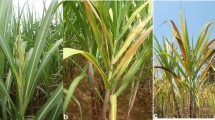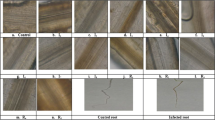Abstract
Wilt of sugarcane is a serious disease affecting sugarcane production in many sugarcane growing regions. Since the associated pathogen has not been clearly established with the disease, detailed studies were conducted to identify the fungal species by pathogenicity and molecular variation. Selected 10 isolates of Fusarium associated with sugarcane wilt were tested for their pathogenicity on the cv Co 86032 and among them the isolates Fs 032 TN4L2 and Fs 121 UP1 originated from Tamil Nadu and Uttar Pradesh, respectively had shown severe disease and proved to be more virulent. Also pathogen inoculation by plug method combined with abiotic stress on selected sugarcane varieties at Coimbatore, caused typical wilt symptoms in cvs Co 6304 and Co 86249 and partial symptoms on CoC 90063 and CoC 92061 under field conditions. However, disease at endemic location in Gujarat the cvs Co 86002, Co 95020, Co 97008, Co 98010 and Co 0323 exhibited typical wilt in response to pathogen inoculation by plug method. Further studies on molecular variation using specific RAPD and ISSR markers were taken up to confirm the pathogenic isolates of Fusarium. The molecular markers such as 1000 bp fragment of RAPD primer OPA13, 650 bp fragment in ISSR1, 720 bp fragment in ISSR5 and 880 bp fragment in ISSR9 very clearly demarcated pathogenic and nonpathogenic isolates. The field and laboratory studies very clearly confirmed that the wilt pathogenic isolates belong to F. sacchari and this is the first attempt that generated molecular markers which correlated with pathogenicity of F. sacchari isolates.




Similar content being viewed by others
References
Abbott, E.V. 1932. Seed rots of sugarcane in Louisiana. In Proceedings of International Society for Sugar Cane Technologists, 4th Congress Bulletin, 48: 1–2.
Agnihotri, V.P., and G.P. Rao. 2002. A century status of sugarcane wilt in India. In Sugarcane crop management, ed. S.B. Singh, G.P. Rao, and S. Eswaramoorthy, 145–160. Houston, TX: SciTech Publishing LLC.
Agnihotri, V.P., and R.P. Singh. 1989. Sugarcane wilt current status. In Prospective in plant pathology, ed. V.P. Agnihotri, N. Singh, H.S. Chaube, U.S. Singh, and T.S. Dwivedi, 227–237. New Delhi, India: Today and Tomorrow’s Printers and Publishers.
Bourne, B.A. 1922. Researches on the root diseases of sugarcane. Barbados: Advocate Co. Ltd., 1–17.
Bourne, B.A. 1933. Sugarcane breeding experiments. Annual Research Report for the Florida Agricultural Experiment Stations, Florida, 180–181.
Butler, E.J., and A.H. Khan. 1913. Some new sugarcane diseases. Part I, wilt. Memoirs of the Department of Agriculture in India, Botanical Series 6: 180–190.
DuTeau, N.M., and J.F. Leslie. 1991. A simple, rapid procedure for the isolation of DNA for PCR from Gibberella fujikuroi (Fusarium section Liseola). Fungal Genetics Newsletter 38: 72.
Egan, B.T., R.C. Magarey, and B.J. Croft. 1997. Sugarcane. In Soil borne diseases of tropical crops, ed. R.J. Hillocks, and J.M. Walker, 277–302. Wallingford, Oxon: CAB International.
Gams, W. 1971. Cephalosporium-artige Schimmelpilze (Hyphomycetes). Stuttgart, Germany: Gustav Fischer Verlag.
Luthra, J.C. 1936. Some new diseases of sugarcane discovered in the Punjab. International Bulletin of Plant Protection 10: 261–262.
Ma, L., H.C. van der Does, K.A. Borkovich, Coleman, et al. 2010. Comparative genomics reveals mobile pathogenicity chromosomes in Fusarium. Nature 464: 367–373.
Martin-Leake, H. 1944. Red rot of the sugarcane. International Sugar Journal 46(541): 7–8.
Mc Rae, W. 1932. Report of the imperial mycologist. Scientific reports of the Imperial Institute of Agricultural Research, Pusa, 28–36.
Mohanraj, D., and K.C. Alexander. 1984. A qualitative numerical index for rating severity in sugarcane wilt. Indian Journal of Sugar Crops 10: 19–20.
Nirenberg, H.I. 1976. Untersuchungen über die morphologische und biologische Differenzierung in der Fusarium Sektion Liseola. Mitteilungen aus der Biologischen Bundesanstalt Für Land- und Forstwirtschaft (Berlin—Dahlem), vol. 169, 1–117.
Nirenberg, H.I., and K. O’Donnell. 1998. New Fusarium species and combinations within the Gibberella fujikuroi species complex. Mycologia 90: 434–458.
Padwick, G.W. 1942. Scientific reports of the Indian Agricultural Research Institute, New Delhi, 1940–1941.
Poongothai, M. 2010. Cultural, morphological, molecular and pathogenic characterization of pathogen(s) causing sugarcane wilt in India. PhD Thesis, Bharathiyar University, Coimbatore, India.
Rafay, S.A. 1952. Wilt disease of sugarcane. Sugarcane Research Station, Pusa, Bihar (India) Science Bulletin, 2, 30.
Sattar, M.A., and S. Ali. 1981. Etiology of wilt disease of sugarcane. Sugarcane Pathologists’ Newsletter 26: 35–37.
Siddique, S.N. 2007. Pathogenicity and aethiology of Fusarium species associated with pokkah boeng disease on sugarcane. Thesis, University of Malaysia, Malaysia.
Singh, K., and R.P. Singh. 1974. Involvement and pathogenicity of Acremonium in wilt syndrome of sugarcane. Sugarcane Pathologists’ Newsletter 11(12): 24–25.
Subramaniam, L.S., and B.L. Chona. 1938. Notes on Cephalosporium sacchari causal organism of sugarcane wilt. Indian Journal of Agricultural Sciences 8: 189–190.
Viswanathan, R. 2010. Plant disease: Red rot of sugarcane. New Delhi: Anmol Publishers, India.
Viswanathan, R., and P. Padmanaban. 2008. Hand book on sugarcane diseases and their management, 80. Sugarcane Breeding Institute, Coimbatore, India.
Viswanathan, R., P. Malathi, A. Ramesh Sundar, M. Poongothai, and N. Singh. 2006. Current status of sugarcane wilt in India. Sugar Cane International 24(4): 1–7.
Waraitch, K.S. 1981. Wilt disease in Co 1148 in Punjab and assessment of losses caused by it. Indian Sugar 31: 37–40.
Acknowledgments
The authors grateful to Dr. N. Vijayan Nair, the Director of the Institute, for providing facilities and encouragement. Financial support received from ICAR, New Delhi as Network Project is also acknowledged.
Author information
Authors and Affiliations
Corresponding author
Rights and permissions
About this article
Cite this article
Viswanathan, R., Poongothai, M. & Malathi, P. Pathogenic and Molecular Confirmation of Fusarium sacchari Causing Wilt in Sugarcane. Sugar Tech 13, 68–76 (2011). https://doi.org/10.1007/s12355-011-0066-4
Received:
Accepted:
Published:
Issue Date:
DOI: https://doi.org/10.1007/s12355-011-0066-4




